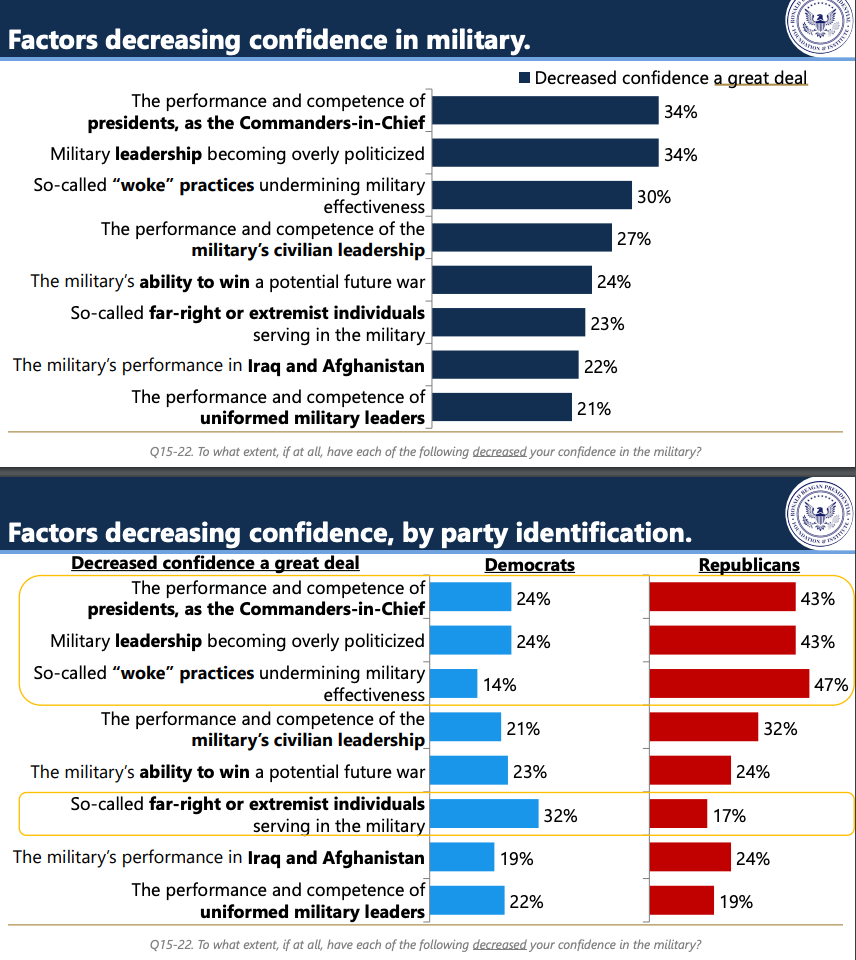America is about to pass the biggest peacetime military budget of any nation in history. And yet, as the excellent Van Jackson (@WonkVJ) notes, American militarism is not in a happy place. “It is wild that the House is appropriating $886 billion for the defense budget … and NOBODY is happy with it.”
With good reason Van Jackson concentrates on the grand strategic issues. As he points out, in an increasingly multipolar world, the demand that the US should be able to beat anyone, anywhere, any time, is a recipe for frustration. As he puts it in another tweet “In a multipolarizing world, there is no real-world force that can close the gap … generated by a (global) primacy strategy.” The litany of gigantic, over-budget weapons projects (F35) and prestige military objects of dubious value (carrier groups) attests to this fact.
At the same time as the external demands are excessive, the domestic political foundation of US militarism are fraying as well. In recent years it was something of a cliché that the one thing that a divided US polity could agree on was more military spending. Now, not even that is true, at least not without “culture war” riders.
In Congress the GOP are holding the defense budget and senior appointments to ransom. Amongst the wider American public the image of the military has sharply declined. Meanwhile, the newest branch of the US armed forces.- the Space Force - launched in 2019 by President Trump, is quite literally a laughing-stock. At a moment of world historic confrontation the politics of American militarism are, all at the same time, a matter of deadly seriousness, blatant pork barrel vote-buying, supercharged culture wars and kitsch. You might say that it has ever been so. It is a myth to imagine a once-clean militarism. Actually existing militarism is always “messy” - a conflict zone of social, economic and political forces. But America’s current cocktail is both particularly potent and particularly toxic.
***
The most conspicuous example of this fraying are the remarkable antics of Congressional Republicans. As the Washington Post commented:
For decades, bipartisan majorities in Congress approved the annual defense authorization bill ... That long-standing practice collapsed this week … The House narrowly approved the National Defense Authorization Act by a vote of 219-210. Four Democrats supported it; four Republicans opposed it. Last December, the defense authorization cleared the House by 350-80, when Democrats held a slim majority in the chamber and the GOP’s far-right Freedom Caucus held little sway. There is no realistic chance that the Democratic-controlled Senate will go along with the House version approved Friday, which includes limits on abortion, transgender transition treatment, diversity training and other matters. The Senate is almost certain to return to the House a defense bill stripped of those controversial Republican amendments. The bill would then face an uncertain future as some House Republicans who pushed through the amendments have vowed to hold the line …
On the same issues - above all abortion - Sen. Tommy Tuberville of Alabama has been holding up hundreds of Pentagon promotions for high-ranking officers. The result is to sabotage the circulation of military elites. As the New York Times reports: “More than half of the current Joint Chiefs are expected to step down from their posts during the next few months without a Senate-approved successor in place”.
No doubt a procedural work-around will be found to ensure that the US military has a command chain in place. But the attitude of the far-right to the US military leadership was well articulated back in the spring by Tuberville. When challenged on his blockade of senior appointments, Tuberville shot back: “Experts have known for more than a decade that the military is top heavy. We do not suffer from a lack of generals,"
For many on America’s right-wing the emblem of the “top heavy”, liberal minded, “political” leadership of the US military is Mark Milley, Chairman of Joint Chiefs of Staff. In 2020 Milley clashed with President Trump and felt forced to make contact with his Chinese counterparts to convey “reassurance in order to maintain strategic stability.” Since then Trump has accused Milley of “TREASON.” Sen. Marco Rubio (R-Fla.) wants him “immediately” fired and Sen. Rand Paul (R-Ky.) wants him court-martialed.
It is worth pausing to consider the implications of this escalation between the US military top brass and the radical right-wing of the Republican party. If Trump were to take office again in January 2025, how would he act in relation to a military command chain with which he was so conspicuously at odds?
Milley went on to rub salt in the wound with his robust defense of a military curriculum at West Point that included works on Critical Race Theory. In response to criticism by the likes of Rep. Mike Waltz (R-Fla.) Milley replied: “I’ve read Mao Zedong. I’ve read Karl Marx. I’ve read Lenin. That doesn’t make me a communist … what is wrong with understanding … the country which we are here to defend?”
The question, of course, is precisely what country is Milley defending? The vision of the United States defended by Florida Republicans does not encourage the reading of Mao, Marx or Lenin. High-profile Florida Republican Matt Gaetz responded to Milley’s remarks by tweeting contemptuously: “With Generals like this it’s no wonder we’ve fought considerably more wars than we’ve won.”
***
Of course, Tuberville, Gaetz and Waltz are attention-seekers. But the fact that they court such controversy points to the fact that there is a groundswell of right-wing opinion, which see the US military leadership not simply as defenders of America, but as “political” and as complicit with a liberal agenda that is anathema to conservative Americans. This is revealed by striking polling figures compiled by the Ronald Reagan Presidential Foundation and Institute. These show that though the US military retain more trust than any other institution in American society, that trust has dwindled dramatically in recent years.
From a high of 70 percent in 2018 the share of Americans expressing a great deal of trust for the US military plunged to 45 percent in 2021 before recovering to 45 percent in 2022. The singles biggest cause for this collapse is the perception on the part of conservative Americans that the military leadership has become “politicized” and complicit with the liberal agenda they identify with “woke”. These domestic political issues and in particular the suspicions of conservative Americans far outweigh any negative judgements about military competence or failure in Afghanistan.
Strikingly, when you ask which security risks Americans are most afraid of, what, in other words, they need defending against, what came top in 2022 were not foreign threats, but “political divisions within the US leading to violence.” 85 percent of Americans are concerned about that scenario and this fear of domestic political violence was shared by both sides (88 Democrat v. 85 percent GOP). Unsurprisingly, Democrats were also more concerned about Russia’s war on Ukraine. Asked to prioritize Russia and China 56 % of Republicans ranked China first, against only 19 percent who put Russia top. 42 % of Democrats put Russia top v. only 32% prioritizing China. Really big gaps opened up, not over Taiwan (69 v. 75), but over the risk of actual war with China, which concerned 59 percent of Democrats v. 79 percent of Republicans. Likewise there was a giant gap on climate change which ranked top for Democrats (91%) v. only 41 % for Republicans.
***
Since the American military is an all-volunteer force public opinion matters not just as political background. To be confident of being able to regularly refresh its ranks, the US military needs not just public affirmation, but also a general conformity between the lifestyles of young people and martial expectations. In this regard too, the disconnect is getting progressively wider.
Among Americans aged 18-29 years of age, just 13% say they are highly willing to join up, 25% are somewhat willing, 20% and not very willing. More than a quarter are a hard no. And the military is not just having a hard time because of this low level of enthusiasm. No more than one in five young Americans meet the military’s physical and mental fitness standards.
As War on the Rocks reported in spring 2023:
During the last fiscal year, the Army missed its recruiting goal by 15,000 active-duty soldiers, or 25 percent of its target. This shortfall forced the Army to cut its planned active-duty end strength from 476,000 to 466,000. And the current fiscal year is likely to be even worse.
The Navy and Air Force did better in part because of the help they received from Hollywood.
Navy and Air Force recruiters took advantage of the release of Top Gun: Maverick, which, like its 1986 predecessor, was the highest-grossing film of the year. A recent analysis showed that the original Top Gun boosted reruitment by 8 percent.
Though glamorous CGI may make a difference, structurally, the US military is a highly self-recruiting group. As David Barno and Nora Bensahel point out, 80 percent of the young people who join the military today have a family member in the military. Iit may well be that more military families are steering their children away from uniformed service toward civilian careers. And this effect may be all the more pronounced because the regions where US military culture is most deeply entrenched, are also in the Republican-dominated regions of the South where the agitation against America’s “woke” military leadership has been most intense.
One indicator of this concentration is the distribution of the Junior Reserve Officers’ Training Corps (JROTC) program in High Schools across the USA. This program, provides “leadership and citizenship instruction” to more than half a million high school students each year. But it is concentrated overwhelmingly in the South.
It is precisely in the Southern states where military culture is most widely socialized that the agitation about “woke” and the liberal proclivities of America’s military leadership is most intense. They have more skin in the game.
***
Despite all these anxieties, amongst young Americans a recent poll revealed strongly favorable attitudes towards all branches of the US military, except one, the newest branch - the Space Force. As the pollsters were eager to point out, the problem was not that the Space Force had particularly high negative ratings. The main problem was that 36% simply did not know what to make of the Force at all. This is both unsurprising and also revealing about the dilemmas of 21st-century militarism in the US.
The Space Force was conjured out of a hat by President Trump in 2019. In a Presidency that was in large part a gigantic exercise in wrestling-mania kitsch, this might be the most kitsch moment of all. So much so that it has left many Americans wondering whether the newest branch of America’s military can possibly be real.
As newly commissioned Space Force officers have found to their embarrassment, staff at airport counters are not always easy to convince that their branch of the military is not a cheaply made Netflix show. As one officer explained to Military.com on condition of anonymity for fear of reprisal by Space Force superiors. "We tried to take it on methodically and convince him that the Space Force was real." But to no avail. It was not until an airline supervisor intervened that the issue Space Force’s existence was resolved and the appropriate baggage discount was granted.
In fact, the Space Force is very real indeed. Its budget of $30 billion is on a par with that of newly gung-ho Poland. Nor is there any doubt that the Space Force, in defending America’s space infrastructure, fulfils an important function with real impact on everyday life in America. As Space Force Major General DeAnne Burt noted: Most people are not aware of their reliance on satellites for routine daily activities like using GPS or trading stocks, and what could happen if satellites in orbit were taken out of service. “We need to talk about it as much as we can,” she averred.
But Space Force’s issues go beyond proving their relevance to the stock-trading, Robinhood and Reddit crowd. Having been founded as the first new branch of the US military since the Air Force in 1947 may have satisfy President Trump’s vanity, but it has become an albatross for the Space Force leadership. In an age of self-fashioning and identity politics, how do you found a new branch of 21st-century militarism? What identity are they to give their relatively small unit of 14,000 personnel and 100 satellites? So far, their efforts have yielded a series of announcements that tread a fine line between military tradition, corporate branding and parody.
Setting up a new branch of the military poses basic questions like, what are its members to be called? This isn’t a matter of pronouns, but of names. Are Space Force members space soldiers? Or space sailors? With its typical thoroughness, the Pentagon entered into a “yearlong process that produced hundreds of submissions and research involving space professionals and members of the general public”, to arrive at the conclusion:
No, I could not decide whether it is a spoof or not, either. But yes, Guardian really is the chosen name of the newest branch of US military power. That is what they insist we should call them. And, no don’t laugh, that logo is not from StarTrek. It really is the logo of the Space Force.
America is a society very preoccupied with naming. And the Pentagon is no exception. It takes the naming business intensely seriously:
The opportunity to name a force is a momentous responsibility. Guardians is a name with a long history in space operations, tracing back to the original command motto of Air Force Space Command in 1983, “Guardians of the High Frontier.”
Not satisfied with the pompous title of guardians and the corny emblem, individual units of the new force go one better. Take the 750th Operations Group, 50th Space Wing. It was activated in July 2020 as Space Delta 9. Not satisfied with that groovy title, Space Delta 9 decided to go one better and to add the moniker “Stormbringers”. Why? Because on the afternoon they were activated in July 2020:
a thunderstorm came rolling over the horizon during the ceremony establishing the unit in 2020. “It's become a rallying cry for Delta 9 and it came out of that first day when we were activated, and we saw the power of the Great Plains of Colorado come to bear on us that day, which is something that a lot of the members here, I'd say all of them, really take to heart and say that, when called upon, Delta 9 will bring the storm,” Bigley said.
Having given themselves a name, a logo and some jazzy handles, Space Force also needed a pep-song. Having no songs to inherit, they had to write one from scratch. Unfortunately on this occasion, rather than picking one of the many excellent Sci-Fi theme tunes for inspiration they instead rummaged around gilded age “fight songs”, and came up with “Semper Supra”. I challenge you to listen to it with a straight face!
And the embarrassment does not stop there. Most militaries inherit their dress costumes from an earlier age in which dress uniforms seemed more in keeping with the times. The true weirdness of military display strikes us as less odd when we submerged it into an unquestioned inheritance. But, what do you do if you are a new branch of the military, in 21st-century America? Well, if you are the Space Force, you go fabulous, Sci-Fi fabulous! Instead of some modest adaptation of an Air Force uniform, the Space Force with less than 10,000 uniformed personnel, commissioned entirely new outfits - starting, for once, with the women’s uniform - and drawing inspiration from … yup … you guessed it … Battlestar Galactica!
***
But remember, Space Force is real. $30 billion of real. And it is part of the immensely complicated American military machine. And that machine is located in real places. And that is where the politics shifts into a different gear.
The Space Force itself, like the army and the air force, is based in the Pentagon. Individual units likes the Space Delta 9 “Stormbringers” are in locations like Peterson Air Force Base in Colorado Springs. Coordinating the units provided by Space Force with other military space assets is Space Command. Reactivated in 2019 at the same time as Space Force was created, it is the extraterrestrial combat organization.
Space Command is currently located in Peterson Colorado. This puts it alongside the National Space Defense Center and the control center for the GPS constellation of satellites, based out of nearby Schriever Air Force Base. Colorado Springs is also the HQ or NORAD, the Cold War era early warning satellite and radar detection system, the ones who track Santa.
But space means rockets, and rockets in America means not Colorado Springs, but Alabama and, in particular Huntsville Alabama otherwise known as Rocket City. From 1950 onwards the decision to move Wernher von Braun’s German rocket team to Huntsville - previously known as the Watercress capital of the world - created a regional military-industrial complex sometimes known as Pentagon South. For decades Richard Shelby the senior Senator for Alabama as Chair of the Senate Appropriation’s Committee controlled the budget of NASA and much else besides and ensured that the Marshall Space Flight Center remained firmly located in Huntsville. Apart from NASA, Huntsville is home also to large facilities of Lockheed Martin (where the Javelin missile is produced), and United Launch Alliance as well as the U.S. Space Camp.
On January 14 2021, on her way out the door, just prior to Biden’s inauguration, Trump’s Air Force Secretary Barbara Barrett designated Redstone Arsenal in Huntsville as the ultimate home for Space Command. This tied America’s new space militarism directly to the Alabama Republican Congressional lobby. So blatant was this move that the final decision was immediately suspended by the Biden administration and the process of decision-making subjected to several years of scrutiny. The decision is still pending. And this means that the decision on Space Command has been sucked into the current travails of American militarism, which have Alabama as one of their chief battlegrounds.
Alabama has not just some of the most right-wing politicians. It also has the most punitive anti-abortion laws in the United States. This is the status quo that Sen. Tommy Tuberville defends with his demand that the Pentagon end support for female members of the force seeking abortions in states where it is still legal. As NBG News reported, the White House wants to suspend the relocation of Space Command to Alabama precisely because of this issue. At a a Senate Armed Services hearing, Sen. Jeanne Shaheen, D-N.H., noted that the Missile Defense Agency lost 80 percent of its workforce when it moved to Alabama in 2005. It is generally agreed that Space Command’s uniformed professional military members will likely follow orders to relocate from Colorado. But they make up only 38 percent of the command’s workforce. Whether the other 62 percent - who are DOD civilians— will be willing to move is an open question.
***
In a recent memo Space Force chief of space operations Gen. Chance Saltzman stated that “Our effectiveness as a military organization depends on an unassailable relationship with the society we serve.” But in a divided America, that precisely is the question. What does it mean for a diverse organization of men and women, wielding means of destruction on a giant scale, backed by more financial resources than any similar organization in history, to maintain an “unassailable” relationship with a society that includes both the liberal parts of American society and Senator Tuberville and Alabama’s abortion laws?
***
Thank you for reading Chartbook Newsletter. It is rewarding to write. I love sending it out for free to readers around the world. But it takes a lot of work. What sustains the effort are voluntary subscriptions from paying supporters. If you are enjoying the newsletter and would like to join the group of supporters click below. As a token of appreciation you will receive the full Top Links emails several times per week.









Military as sacred cow, bloated budgets for things the country doesn't need, unending bitch fights over cultural issues primarily intended to score points at the expense of the other team, the list goes on.
Sounds like a third world country. But a third world country with nukes and a hyperbelligerent foreign policy.
Tremendous stuff, this. Without a root-and-branch reform beginning with some coherent understanding of what constitutes the legitimate security needs of the United States this rudderless and bloated military along with the n-many jackals feasting thereupon will continue to drift aimlessly until a crisis forces a concentration of minds. Don't be too terribly surprised if the crisis in question turns out to be domestic ...